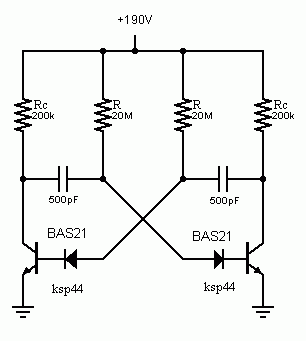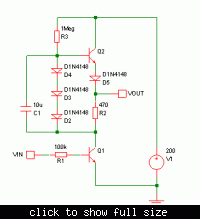Artlav
Full Member level 2
Hello.
I'm trying to make an oscillator that would run from 200V range, providing about 1 kHz with minimal current drain.
I started with making a test one that would fit the parts i had on hand and to check the theory.
The transistors are ksp44, apparently with Vcesat=0.4V, Vbesat=0.75 and gain of 40 to 200.
Now, if i understand this right:
Ic=1mA
C=500pF
Rc=(V-Vcesat)/Ic=199KΩ
R=(V-Vbesat)/(Ic/gain)=19.925MΩ
f=1/(1.386*C*R)=72Hz
Thus, the rounded up result:

However, this circuit have two problems.
First, it oscillates at about 700Hz, not 72.
Second, it only peaks to 90V at collectors, not 190.
So, the question is - what did i do wrong?
Transistor's datasheet only lists ratings at 10V, can they be wildly different at 200V?
Secondary question - is there a better kind of oscillator to get 1kHz at 200V with less than 1mA of consumption?
With smaller capacitors needed for kHz range this kind of circuit stops working at all.
I'm trying to make an oscillator that would run from 200V range, providing about 1 kHz with minimal current drain.
I started with making a test one that would fit the parts i had on hand and to check the theory.
The transistors are ksp44, apparently with Vcesat=0.4V, Vbesat=0.75 and gain of 40 to 200.
Now, if i understand this right:
Ic=1mA
C=500pF
Rc=(V-Vcesat)/Ic=199KΩ
R=(V-Vbesat)/(Ic/gain)=19.925MΩ
f=1/(1.386*C*R)=72Hz
Thus, the rounded up result:

However, this circuit have two problems.
First, it oscillates at about 700Hz, not 72.
Second, it only peaks to 90V at collectors, not 190.
So, the question is - what did i do wrong?
Transistor's datasheet only lists ratings at 10V, can they be wildly different at 200V?
Secondary question - is there a better kind of oscillator to get 1kHz at 200V with less than 1mA of consumption?
With smaller capacitors needed for kHz range this kind of circuit stops working at all.


